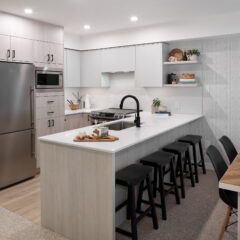Introduction
Welcome, fellow homeowner, to a world of endless possibilities for transforming your living space! If you’ve been on the hunt for the perfect way to renovate your home, you’ve landed on the right page.
In this comprehensive guide, we delve into the realm of “Tile options for your home renovation,” equipping you with insights that will empower your creative journey. Whether you’re planning to revamp your bathroom, kitchen, or any other area, we’re here to make the process smooth, enjoyable, and truly transformative. So, let’s embark on this engaging journey of discovery and exploration together!
Ceramic Tile
What are they
Ceramic tiles are versatile and durable flooring and wall covering options made from clay and minerals. They are kiln-fired to achieve the desired hardness and texture. Available in various sizes, shapes, colors, and patterns, ceramic tiles offer a wide range of design possibilities for your home renovation projects.
What are the benefits
Durability: Ceramic tiles are known for their long-lasting nature, making them ideal for high-traffic areas.
Versatility: With countless design options, you can achieve different styles, from classic to modern.
Easy Maintenance: Their smooth surface is easy to clean, and ceramic tiles are resistant to stains and water.
Affordability: Ceramic tiles provide an economical way to elevate your home’s aesthetics.
Hypoallergenic: They don’t harbor allergens, making them a good choice for allergy-prone individuals.
What are the disadvantages
Hardness: Being a rigid material, ceramic tiles can be uncomfortable to stand on for long periods.
Susceptible to Cracking: Heavy impacts can cause tiles to crack or chip.
Cold Surface: They can feel cold, especially during colder seasons.
Where are they commonly used
Ceramic tiles are commonly used in kitchens, bathrooms, and entryways due to their durability and water resistance. They are also a popular choice for backsplashes and feature walls.
Want to know more
If you want to know more about ceramic tiles, read our dedicated article on ceramic tile options for your home renovation.
Porcelain Tiles
What are they
Porcelain tiles are premium ceramic tiles made from refined clay and minerals that are fired at higher temperatures than regular ceramic tiles. This results in a dense, durable, and water-resistant tile with a low water absorption rate. Porcelain tiles come in a variety of styles and finishes, making them a versatile choice for home renovation projects.
What are the benefits
Durability: Porcelain tiles are extremely durable and resistant to wear, making them suitable for high-traffic areas.
Water Resistance: Their low water absorption rate makes them ideal for bathrooms, kitchens, and other wet areas.
Low Maintenance: Porcelain tiles are easy to clean and maintain due to their non-porous surface.
Design Options: They offer a wide range of design options, including patterns that mimic natural stone, wood, and other materials.
Longevity: Porcelain tiles have a long lifespan, ensuring that your investment lasts for years.
What are the disadvantages
Cost: Porcelain tiles are generally more expensive than other tile options.
Installation: Their density requires special equipment and expertise for installation.
Hardness: Similar to ceramic tiles, porcelain tiles can be uncomfortable to stand on for extended periods.
Where are they commonly used
Porcelain tiles are commonly used in areas where durability and water resistance are essential, such as bathrooms, kitchens, and outdoor spaces. They are also used for flooring, walls, and even countertops.
Want to know more
If you want to know more about porcelain tiles, read our dedicated article on porcelain tile options for your home renovation.
Marble Tiles
What are they
Marble tiles are elegant and luxurious natural stone tiles that are cut from large marble blocks. Known for their distinctive veining patterns and rich colors, marble tiles add a touch of sophistication to any space. They are a popular choice for adding a timeless and upscale look to your home.
What are the benefits
Elegance: Marble tiles are prized for their luxurious appearance and unique veining, adding a touch of opulence to your interiors.
Variety: Available in a wide range of colors and patterns, marble tiles allow you to create personalized and eye-catching designs.
Cooling Effect: Marble’s natural properties help keep the surface cool, making it suitable for warmer climates.
Increase Home Value: The high-end nature of marble can increase the resale value of your home.
Durability: While softer than some other stones, marble tiles are still durable and can last for decades with proper care.
What are the disadvantages
Maintenance: Marble is porous and can be prone to staining, requiring regular sealing and careful maintenance.
Cost: Marble tiles are a premium option and can be more expensive than other materials.
Scratches and Etching: Marble is susceptible to scratches and etching from acidic substances.
Where are they commonly used
Marble tiles are commonly used in areas where their elegant appearance can shine, such as bathrooms, entryways, and living areas. They are also used for decorative accents, fireplace surrounds, and countertops.
Want to know more
If you want to know more about marble tiles, read our dedicated article on marble tile options for your home renovation.
Travertine Tiles
What are they
Travertine tiles are natural stone tiles formed from the mineral deposits of hot springs. They exhibit a unique combination of earthy tones and a porous texture that adds a rustic charm to your living spaces. Travertine tiles are available in various finishes, making them a versatile choice for both indoor and outdoor applications.
What are the benefits
Natural Beauty: The inherent variations in color and texture lend a warm and natural aesthetic to your interiors.
Durability: Travertine is a durable material that can withstand moderate foot traffic and wear.
Cooling Effect: Similar to marble, travertine has a cooling effect, making it comfortable to walk on even in warmer weather.
Timeless Appeal: Travertine’s classic appearance ensures that it remains stylish and relevant for years.
Outdoor Versatility: These tiles are suitable for outdoor patios, pool decks, and pathways.
What are the disadvantages
Porosity: Travertine’s porous nature requires regular sealing to prevent staining and damage.
Maintenance: Ongoing maintenance is needed to preserve the appearance and longevity of the tiles.
Surface Irregularities: The naturally occurring holes and pits may not appeal to those seeking a completely smooth surface.
Where are they commonly used
Travertine tiles find a place in both indoor and outdoor areas. They are often used in living rooms, kitchens, bathrooms, and hallways. Outdoors, they are favored for their ability to blend seamlessly with nature.
Want to know more
If you want to know more about travertine tiles, read our dedicated article on travertine tile options for your home renovation.
Mosaic Tiles
What are they
Mosaic tiles are a captivating and artistic tile option that involves small pieces of glass, stone, ceramic, or other materials arranged together to create intricate patterns and designs. These tiles offer a unique way to add color, texture, and personality to your home.
What are the benefits
Artistic Expression: Mosaic tiles allow you to create custom designs, patterns, and even intricate images in your living spaces.
Versatility: They come in various materials, sizes, and colors, offering endless possibilities for creativity.
Visual Interest: Mosaic tiles catch the eye with their intricate details, becoming a focal point in any room.
Flexibility: Mosaic tiles can be used on walls, floors, backsplashes, and even as decorative accents.
Texture Play: The varied textures of different materials in mosaic tiles add depth and tactile appeal.
What are the disadvantages
Installation Complexity: Proper installation of mosaic tiles requires skill and precision due to their small size and intricate patterns.
Maintenance: The grout lines between the tiles can be challenging to keep clean and may require regular maintenance.
Cost: Depending on the complexity of the design and the materials used, mosaic tiles can be more expensive.
Where are they commonly used
Mosaic tiles are commonly used in bathrooms, kitchens, and showers to create stunning focal points. They are also popular as decorative borders, backsplashes, and even outdoor murals.
Want to know more
If you want to know more about mosaic tiles, read our dedicated article on mosaic tile options for your home renovation.
Glass Tiles
What are they
Glass tiles are modern and sleek tile options made from pieces of glass that are fused together. They come in various shapes, sizes, and finishes, allowing you to create a stunning visual impact in your home. Glass tiles reflect light and add a touch of elegance to any room.
What are the benefits
Reflective Properties: Glass tiles create a luminous and reflective surface that amplifies light, making spaces feel brighter and more open.
Color Depth: The translucent nature of glass enhances the depth and vibrancy of colors, adding visual interest.
Easy Maintenance: The non-porous surface of glass tiles is resistant to stains and moisture, making them easy to clean.
Design Flexibility: From subtle neutrals to bold hues, glass tiles offer a wide range of color options for your creative expression.
Modern Aesthetic: Glass tiles lend a contemporary and sophisticated look to any interior.
What are the disadvantages
Installation Precision: Glass tiles require precise installation to achieve a smooth and even surface.
Scratch Susceptibility: Glass tiles can be more prone to scratching compared to other materials, so care is needed during maintenance.
Cost: Glass tiles are generally more expensive than traditional ceramic tiles.
Where are they commonly used
Glass tiles are commonly used as backsplashes in kitchens and bathrooms to add a reflective focal point. They can also be used to create accent walls, shower surrounds, and decorative inserts.
Want to know more
If you want to know more about glass tiles, read our dedicated article on glass tile options for your home renovation.
Granite Tiles
What are they
Granite tiles are natural stone tiles cut from solid blocks of granite, a durable and igneous rock formed from cooled molten magma. Known for their strength and distinctive natural patterns, granite tiles offer a blend of elegance and durability for your home renovation projects.
What are the benefits
Durability: Granite is one of the hardest natural stones, making granite tiles resistant to scratches and impacts.
Unique Patterns: Each granite tile is distinct, showcasing natural variations in color and pattern that add character to your space.
Heat Resistance: Granite tiles are heat-resistant, making them ideal for kitchens and areas where heat exposure is common.
Longevity: Properly sealed and maintained, granite tiles can last for decades while maintaining their beauty.
Value Addition: The premium nature of granite can enhance the overall value of your home.
What are the disadvantages
Weight: Granite tiles are heavy, which can require additional structural support during installation.
Sealing: Granite tiles are porous and require regular sealing to prevent staining and moisture penetration.
Maintenance: The surface can be susceptible to water spots and acidic stains if not properly maintained.
Where are they commonly used
Granite tiles are commonly used in kitchens for countertops and backsplashes due to their durability and resistance to heat. They are also popular for bathroom vanities and flooring.
Want to know more
If you want to know more about granite tiles, read our dedicated article on granite tile options for your home renovation.
Slate Tiles
What are they
Slate tiles are natural stone tiles extracted from fine-grained metamorphic rock. They are characterized by their unique textures, layers, and earthy colors, giving your space a rustic and natural feel. Slate tiles are a popular choice for those seeking a distinctive and timeless look.
What are the benefits
Natural Texture: The uneven surface and layers of slate tiles add a tactile and organic quality to your interiors.
Rich Colors: Slate tiles come in a variety of rich earth tones, offering a warm and inviting ambiance.
Durability: Slate is a dense and durable material, making slate tiles suitable for high-traffic areas.
Water Resistance: When properly sealed, slate tiles exhibit excellent water resistance, making them ideal for wet areas.
Low Maintenance: Sealed slate tiles require minimal maintenance to retain their appearance.
What are the disadvantages
Variability: The natural variations in color and texture of slate tiles may lead to inconsistencies in the final appearance.
Installation Complexity: Due to the varying thicknesses of slate tiles, installation can be more complex and time-consuming.
Sealing: Regular sealing is necessary to prevent water damage and maintain the tiles’ appearance.
Where are they commonly used
Slate tiles are commonly used in outdoor spaces, such as patios, walkways, and pool areas, due to their slip-resistant nature. Indoors, they are popular for adding a touch of natural beauty to living rooms, kitchens, and bathrooms.
Want to know more
If you want to know more about slate tiles, read our dedicated article on slate tile options for your home renovation.
Terracotta Tiles
What are they
Terracotta tiles are unglazed clay tiles that offer a warm and rustic charm to your home. Made from natural clay, these tiles are known for their earthy colors and imperfect, handmade appearance. Terracotta tiles have been used for centuries and continue to bring a sense of history to modern interiors.
What are the benefits
Warmth and Character: The natural warmth and unique variations in terracotta tiles add character and authenticity to your living spaces.
Earthy Tones: Terracotta tiles are available in earthy reds, browns, and oranges that complement a variety of interior styles.
Ageless Appeal: The timeless quality of terracotta tiles makes them suitable for both traditional and contemporary designs.
Cooling Properties: Terracotta tiles have natural cooling properties, making them comfortable underfoot in warmer climates.
Eco-Friendly: Terracotta tiles are made from natural clay and are considered an environmentally friendly option.
What are the disadvantages
Porosity: Terracotta tiles are porous and require proper sealing to prevent water damage and staining.
Maintenance: Regular maintenance, including sealing and occasional refinishing, is needed to keep terracotta tiles looking their best.
Vulnerability to Wear: Terracotta tiles can be more susceptible to chipping and wear in high-traffic areas.
Where are they commonly used
Terracotta tiles are commonly used in kitchens, entryways, and other areas where their warm and inviting appearance can be appreciated. They are also popular for outdoor spaces and garden pathways.
Want to know more
If you want to know more about terracotta tiles, read our dedicated article on terracotta tile options for your home renovation.
Wooden Tiles
What are they
Wooden tiles, also known as wood-look tiles, are ceramic or porcelain tiles that mimic the appearance of natural wood. These tiles offer the beauty of wood with the durability and easy maintenance of tile. They come in various colors, grain patterns, and sizes, providing a versatile option for achieving a wood-inspired look.
What are the benefits
Natural Aesthetics: Wooden tiles capture the warmth and beauty of real wood, creating a cozy and inviting ambiance.
Durability: Unlike real wood, wooden tiles are resistant to moisture, scratches, and wear, making them suitable for high-traffic areas.
Low Maintenance: Wooden tiles require minimal maintenance compared to real wood, as they don’t require sanding, staining, or sealing.
Versatility: Wooden tiles can be used in areas where natural wood might not be suitable, such as bathrooms and basements.
Consistency: Wooden tiles offer a consistent color and pattern, eliminating the natural variations found in real wood.
What are the disadvantages
Texture: While they replicate the appearance of wood, wooden tiles lack the texture and tactile feel of real wood.
Installation Complexity: Proper installation of wooden tiles requires attention to detail to achieve a realistic wood pattern.
Cooler Surface: Unlike real wood, wooden tiles can feel cooler underfoot, which might be less comfortable in colder climates.
Where are they commonly used
Wooden tiles are commonly used in spaces where the warmth and aesthetics of wood are desired, such as living rooms, bedrooms, and even kitchens. They are also suitable for commercial spaces seeking a natural look without sacrificing durability.
Want to know more
If you want to know more about wooden tiles, read our dedicated article on wooden tile options for your home renovation.
Subway Tiles
What are they
Subway tiles are rectangular tiles known for their clean and timeless design. Inspired by the tiles used in subway stations in the early 20th century, these tiles have become a popular choice for creating classic and versatile looks in various settings. They are typically made of ceramic, porcelain, or glass.
What are the benefits
Versatility: Subway tiles offer a simple and versatile backdrop that complements a range of interior styles.
Visual Illusion: The elongated shape and horizontal layout of subway tiles can make a space appear larger and more open.
Easy Maintenance: The smooth and glazed surface of subway tiles is easy to clean and resists staining.
Color Options: Subway tiles are available in a variety of colors, allowing for creative design possibilities.
Affordability: Subway tiles are often budget-friendly, making them an economical choice for large areas.
What are the disadvantages
Commonality: Due to their widespread use, subway tiles may lack a unique or distinctive look in some settings.
Grout Lines: The abundance of grout lines in subway tile installations can require more cleaning and maintenance.
Design Variation: While classic, the simple design of subway tiles might not suit all design preferences.
Where are they commonly used
Subway tiles are commonly used in kitchens and bathrooms, where their clean lines and timeless appeal create a fresh and classic atmosphere. They are also used for backsplashes, shower surrounds, and even as decorative accents.
Want to know more
If you want to know more about subway tiles, read our dedicated article on subway tile options for your home renovation.
Moroccan Tiles
What are they
Moroccan tiles, also known as Moorish tiles or Zellige tiles, are handcrafted ceramic tiles that showcase intricate geometric and floral patterns. Originating from North Africa, these tiles are known for their vibrant colors and intricate designs that add a touch of exotic elegance to any space.
What are the benefits
Artistic Detail: Moroccan tiles feature stunning patterns and designs that are truly works of art, creating a unique and captivating visual impact.
Rich Cultural Heritage: These tiles carry the rich history and cultural heritage of North African craftsmanship and design.
Customization: Moroccan tiles can be customized in terms of colors and patterns, allowing you to create a truly personalized space.
Eclectic Charm: Whether used as a focal point or as accents, Moroccan tiles infuse spaces with a sense of global, bohemian, or eclectic style.
What are the disadvantages
Complex Installation: The intricate patterns of Moroccan tiles can make installation more challenging, requiring skilled craftsmanship.
Maintenance: The raised patterns on Moroccan tiles can collect dirt and require more meticulous cleaning.
Higher Cost: Due to their handmade nature and detailed designs, Moroccan tiles can be more expensive than other options.
Where are they commonly used
Moroccan tiles are commonly used as decorative accents in kitchens, bathrooms, and living spaces. They are often found on backsplashes, floors, and walls, adding a touch of elegance and cultural richness.
Want to know more
If you want to know more about Moroccan tiles, read our dedicated article on Moroccan tile options for your home renovation.
Spanish Style Tiles
What are they
Spanish style tiles, also known as Mediterranean tiles, embody the vibrant and ornate design of traditional Spanish and Mediterranean architecture. These tiles feature intricate patterns, vivid colors, and a sense of old-world charm that transports you to the sunny regions of Southern Europe.
What are the benefits
Timeless Elegance: Spanish style tiles capture the timeless elegance of Mediterranean design, creating a warm and inviting atmosphere.
Rich Patterns: The intricate and geometric patterns of Spanish tiles are reminiscent of classic Spanish motifs and add depth to your space.
Vivid Colors: The bold and vibrant colors of these tiles can infuse your interiors with a lively and vibrant character.
Authentic Aesthetics: Spanish style tiles authentically replicate the look and feel of historic Mediterranean homes and buildings.
What are the disadvantages
Complex Patterns: The intricate patterns can make installation and alignment more challenging, requiring skilled labor.
Design Balance: Due to their bold patterns and colors, Spanish style tiles may require careful coordination with other design elements.
Higher Cost: The detailed and handcrafted nature of these tiles can contribute to higher costs.
Where are they commonly used
Spanish style tiles are commonly used as focal points or accents in kitchens, bathrooms, and outdoor spaces. They are often found on stair risers, backsplashes, and patios, bringing a touch of Mediterranean elegance.
Want to know more
If you want to know more about Spanish style tiles, read our dedicated article on Spanish tile options for your home renovation.
Natural Stone Tiles
What are they
Natural stone tiles are tiles crafted from various types of natural stones, each with its own unique textures, colors, and characteristics. These tiles offer the authenticity and beauty of nature, bringing the raw elegance of stone into your living spaces.
What are the benefits
Uniqueness: Each natural stone tile is one-of-a-kind, showcasing the distinct patterns and colors of the stone it’s made from.
Variety: Natural stone tiles come in a wide range of options, including marble, granite, travertine, slate, and limestone, allowing you to find the perfect fit for your style.
Timeless Appeal: The enduring beauty of natural stone ensures that your tiles will remain stylish for years to come.
Durability: Depending on the type, natural stone tiles can be exceptionally durable and resistant to wear and tear.
What are the disadvantages
Porosity: Many natural stone tiles are porous and require proper sealing to prevent stains and moisture damage.
Maintenance: Some types of natural stone require more frequent maintenance to preserve their appearance and integrity.
Variability: The variations in natural stone can make achieving a uniform appearance more challenging.
Cost: Natural stone tiles can be more expensive compared to other tile materials due to their unique characteristics.
Where are they commonly used
Natural stone tiles are versatile and can be used in various areas of the home, including kitchens, bathrooms, living rooms, and outdoor spaces. They are often used for flooring, countertops, and wall applications.
Want to know more
If you want to know more about natural stone tiles, read our dedicated article on natural stone tile options for your home renovation.
Terrazzo Tiles
What are they
Terrazzo tiles are a unique type of tile made from a mixture of chips of natural stones or glass embedded in a cement or resin binder. These tiles offer a distinctive speckled or mottled appearance that adds texture, character, and a touch of creativity to your spaces.
What are the benefits
Visual Interest: Terrazzo tiles feature a captivating and artistic look created by the combination of colorful chips and the binder material.
Versatility: Terrazzo tiles can be customized to include various combinations of stones and glass, allowing for endless design possibilities.
Durability: The cement or resin binder makes terrazzo tiles durable and resistant to wear, making them suitable for high-traffic areas.
Sustainability: Terrazzo tiles often use recycled materials, making them an eco-friendly choice for environmentally conscious homeowners.
What are the disadvantages
Complex Installation: Installing terrazzo tiles requires specialized skills and techniques due to the need for precise placement and polishing.
Maintenance: Terrazzo tiles may require occasional resealing and refinishing to maintain their appearance and integrity.
Cost: The intricate design and labor-intensive installation process of terrazzo tiles can contribute to higher costs.
Where are they commonly used
Terrazzo tiles are commonly used in commercial spaces, but their unique and artistic appearance has made them increasingly popular in residential settings as well. They are often used for flooring, countertops, and even decorative wall applications.
Want to know more
If you want to know more about terrazzo tiles, read our dedicated article on terrazzo tile options for your home renovation.
Concrete Tiles
What are they
Concrete tiles are a type of tile made from a mixture of cement, aggregates, and often pigments to create a wide range of designs and colors. These tiles offer a modern and industrial look, combining durability with a sleek and minimalist aesthetic.
What are the benefits
Modern Aesthetics: Concrete tiles provide a contemporary and urban look that suits modern and industrial design styles.
Design Flexibility: Concrete tiles can be customized in terms of colors, shapes, and patterns, allowing for creative and unique designs.
Durability: Concrete tiles are known for their durability and resistance to wear, making them suitable for both indoor and outdoor applications.
Low Maintenance: The sealed surface of concrete tiles is easy to clean and requires minimal maintenance.
What are the disadvantages
Weight: Concrete tiles can be heavy, requiring proper structural support during installation.
Installation Expertise: Proper installation of concrete tiles requires specialized skills to ensure accurate alignment and sealing.
Porosity: If not properly sealed, concrete tiles can be porous and prone to staining from liquids.
Hardness: The hardness of concrete tiles may make them less comfortable to stand on for long periods.
Where are they commonly used
Concrete tiles are commonly used in modern and minimalist spaces, including kitchens, bathrooms, and outdoor areas like patios. They are often chosen for flooring, backsplashes, and accent walls.
Want to know more
If you want to know more about concrete tiles, read our dedicated article on concrete tile options for your home renovation.
Metallic Tiles
What are they
Metallic tiles are a type of tile that features a metallic finish, adding a touch of glamour, shine, and contemporary style to your living spaces. These tiles are often made from materials like porcelain or glass, with a metallic glaze that reflects light and creates a unique visual impact.
What are the benefits
Modern Elegance: Metallic tiles bring a modern and sophisticated look to any room, with their reflective surfaces adding depth and dimension.
Light Reflection: The metallic finish of these tiles reflects light, making spaces appear brighter and more spacious.
Design Variety: Metallic tiles come in various shades of silver, gold, copper, and bronze, allowing you to choose a color that suits your design preferences.
Visual Interest: The metallic shimmer of these tiles can create eye-catching focal points and accents in your interiors.
What are the disadvantages
Maintenance: The metallic finish may require more frequent cleaning to maintain its shine and to prevent water spots or fingerprints.
Scratch Sensitivity: Some metallic tiles can be more prone to scratches and scuffs compared to other types of tiles.
Subtle Variations: Metallic tiles may have subtle variations in color and texture, which can contribute to their uniqueness but might require careful installation.
Where are they commonly used
Metallic tiles are often used as decorative accents in kitchens, bathrooms, and living areas. They are popular for backsplashes, feature walls, and decorative borders.
Want to know more
If you want to know more about metallic tiles, read our dedicated article on metallic tile options for your home renovation.
Penny Round Tiles
What are they
Penny round tiles are small circular tiles that resemble the shape and size of actual pennies, hence the name. These tiles are often made from various materials such as ceramic, glass, or porcelain, and they create a distinctive and charming visual effect.
What are the benefits
Unique Shape: The circular shape of penny round tiles adds a playful and visually interesting element to your space.
Subtle Patterns: When grouped together, penny round tiles create subtle patterns that can add depth and texture to your surfaces.
Design Flexibility: Penny round tiles are available in a variety of colors and materials, allowing for creative and personalized designs.
Versatility: These tiles can be used on both walls and floors, offering flexibility in how you incorporate them into your décor.
What are the disadvantages
Installation Complexity: Installing penny round tiles can be more labor-intensive, requiring precise alignment and grout placement.
Maintenance: The small size of the tiles can result in more grout lines, which may require more cleaning and maintenance over time.
Visual Scale: In larger spaces, the small scale of penny round tiles might not create the impact you desire.
Where are they commonly used
Penny round tiles are commonly used in bathrooms, showers, and backsplashes to create visually appealing and tactile surfaces. They can also be used to add texture and interest to accent walls.
Want to know more
If you want to know more about penny round tiles, read our dedicated article on penny round tile options for your home renovation.
Encaustic Tiles
What are they
Encaustic tiles are handcrafted ceramic tiles known for their intricate and colorful patterns that are created by pressing different colors of clay into a mold. These tiles are then fired, resulting in a durable and visually captivating surface that adds character to your interiors.
What are the benefits
Artistic Detail: Encaustic tiles showcase a high level of artistic craftsmanship, often featuring complex geometric and floral patterns.
Vibrant Colors: The use of multiple colored clays creates a palette of rich and vibrant colors that can enliven any space.
Unique Designs: Each encaustic tile is a work of art, offering distinct patterns and variations that add uniqueness to your surfaces.
Historical Aesthetic: Encaustic tiles evoke a sense of history and timeless charm, often reminiscent of traditional European architecture.
What are the disadvantages
Installation Challenges: The intricate patterns of encaustic tiles can make installation more complex, requiring careful alignment and grout work.
Maintenance: Encaustic tiles may require more diligent cleaning and maintenance to preserve their appearance and intricate patterns.
Higher Cost: The handcrafted nature and artistic quality of encaustic tiles can contribute to higher costs compared to simpler tile options.
Where are they commonly used
Encaustic tiles are often used as focal points in entryways, kitchens, and bathrooms. They can be used for floors, backsplashes, and decorative accents to create visually stunning and memorable spaces.
Want to know more
If you want to know more about encaustic tiles, read our dedicated article on encaustic tile options for your home renovation.
Victorian Style Tiles
What are they
Victorian style tiles are tiles that reflect the design aesthetics of the Victorian era, which spanned from the mid-19th to early 20th century. These tiles often feature intricate patterns, floral motifs, and geometric designs that evoke the elegance and opulence of that time.
What are the benefits
Timeless Elegance: Victorian style tiles bring a sense of classic elegance and vintage charm to your interiors.
Historical Authenticity: These tiles accurately capture the design elements and patterns that were popular during the Victorian era.
Customizable: Victorian style tiles can be customized to match your preferred color scheme and design preferences.
Statement Pieces: Incorporating Victorian style tiles as focal points can create stunning and eye-catching areas within your home.
What are the disadvantages
Complex Installation: Installing Victorian style tiles with intricate patterns may require skilled professionals to ensure proper alignment and symmetry.
Maintenance: The detailed patterns of these tiles can make cleaning and maintaining grout lines more challenging.
Design Compatibility: Victorian style tiles may not seamlessly fit with modern or minimalist design aesthetics.
Where are they commonly used
Victorian style tiles are often used in entryways, hallways, bathrooms, and kitchens to add a touch of historical charm. They are frequently used for decorative borders, feature walls, and fireplace surrounds.
Want to know more
If you want to know more about Victorian style tiles, read our dedicated article on Victorian tile options for your home renovation.
Retro Style Tiles
What are they
Retro style tiles are tiles that capture the design aesthetics of past decades, often drawing inspiration from the mid-20th century. These tiles feature bold colors, geometric patterns, and playful designs that evoke a sense of nostalgia and fun.
What are the benefits
Nostalgic Appeal: Retro style tiles transport you back in time, offering a sense of nostalgia and familiarity.
Playful Patterns: The vibrant colors and bold patterns of retro tiles can infuse energy and character into your spaces.
Versatility: Retro tiles come in various shapes and designs, allowing you to create unique and personalized combinations.
Design Freedom: Incorporating retro tiles allows you to experiment with eclectic and creative design ideas.
What are the disadvantages
Design Compatibility: The distinct look of retro tiles may not seamlessly blend with all design styles and aesthetics.
Visual Overwhelm: Overusing retro tiles can lead to a visually overwhelming effect; careful selection and placement are essential.
Maintenance Considerations: The bold colors of retro tiles may require more frequent cleaning to keep their vibrancy.
Where are they commonly used
Retro style tiles are commonly used in kitchens, bathrooms, and entertainment spaces to create vibrant and eye-catching areas. They are often chosen for backsplashes, accent walls, and decorative borders.
Want to know more
If you want to know more about retro style tiles, read our dedicated article on retro tile options for your home renovation.
Conclusion
Thank you for joining us on this journey through home renovations tile selection. Hope you got some imporatnt insights on advantages and disadvantages of various tile types for your home renovations projects.
Remember, at Fresh Home Renovations, we are always here to assist you in bringing your vision to life. For any queries or assistance, don’t hesitate to reach out to us. Your dream home awaits, and together, we’ll craft a haven of beauty and luxury that reflects your unique taste and personality. Contact us now and let the transformation begin!








